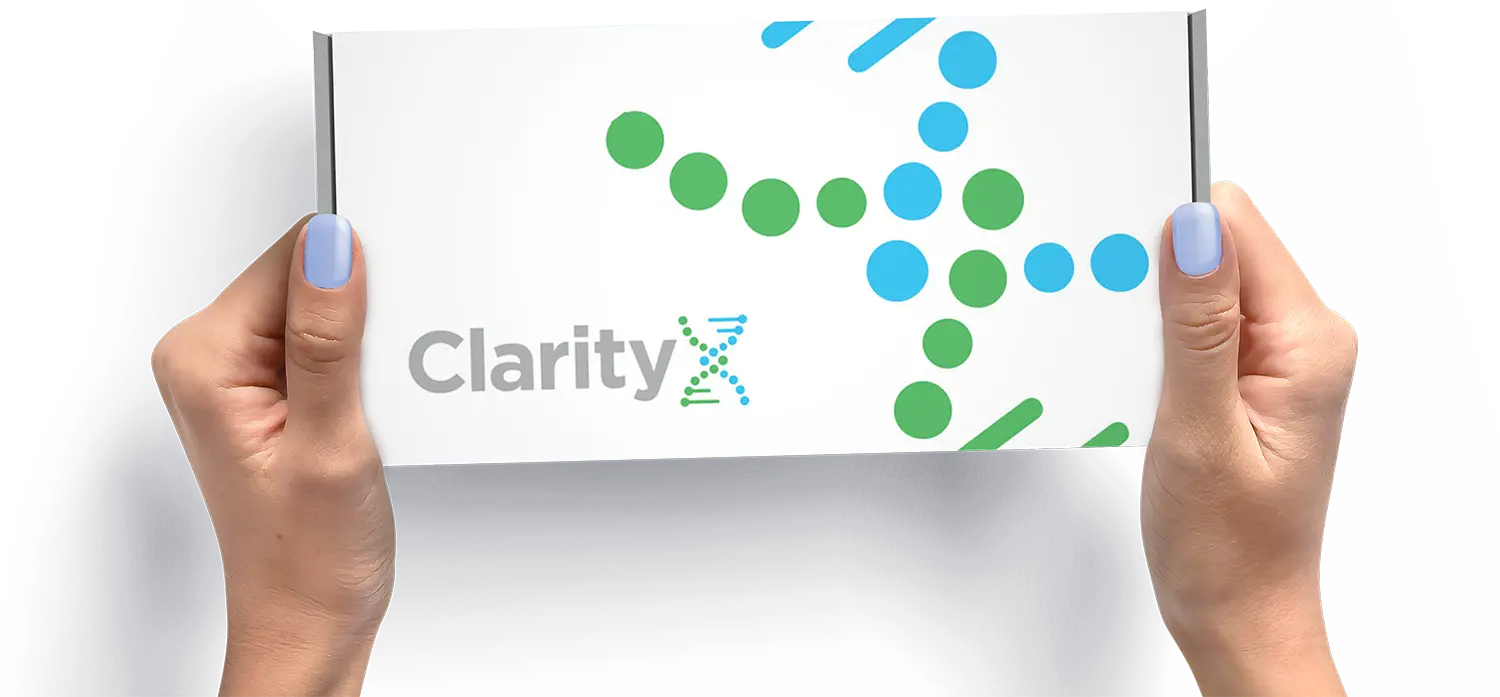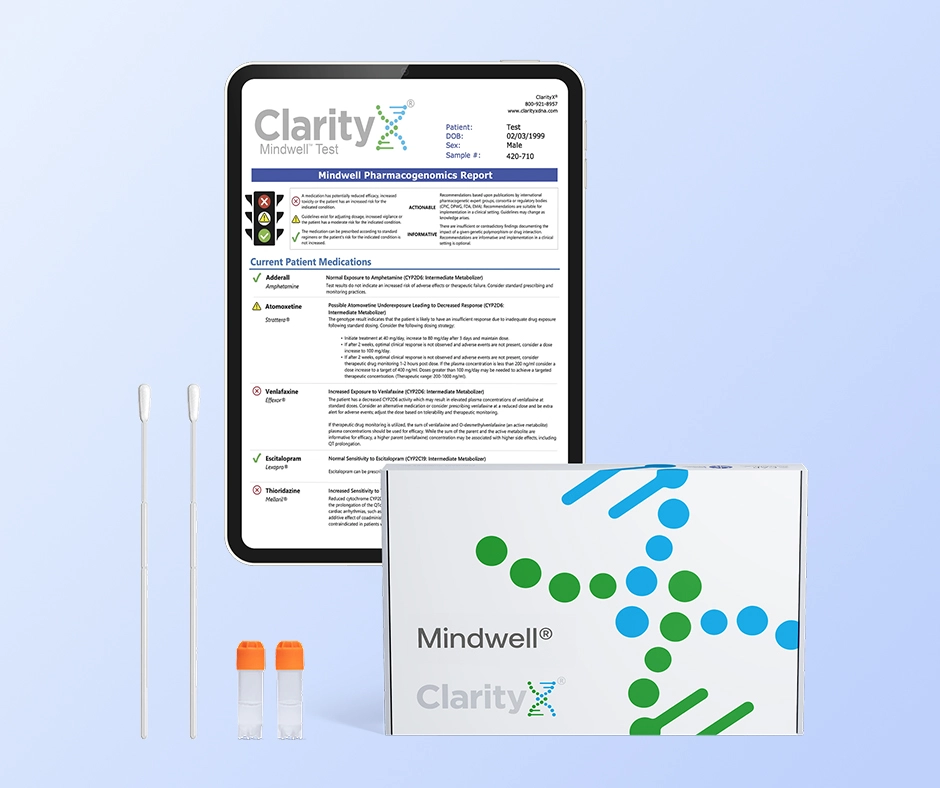Why Is Mental Health Important? From excess schoolwork to career demands, there is no shortage of daily stressors in our lives. As you navigate through these challenges, it’s important to watch out for your mental health. Mental wellness is closely connected to physical health and overall well-being. When your mental health declines, you may experience unpleasant symptoms. These include loss of interest, persistent sadness, trouble sleeping, and loss of appetite.
The most common process used when selecting medications to treat mental health conditions is the trial-and-error approach. A provider simply tries one drug and if it doesn’t work or it results in giving their patient side effects, they simply move on to the next drug. This is not only inefficient, but it also incurs an unnecessary cost, potential side effects, and wasted time for all involved. Pharmacogenomic (PGx) testing can help improve a patient’s mental health journey by providing insight into how they may respond to medications based on their genetics. This tailored approach to selecting medications based on a patient’s PGx testing result can help providers select the right medication from the start.
Introduction
Sertraline (Zoloft) and escitalopram (Lexapro) are antidepressants that are in a class of medications called serotonin reuptake inhibitors (SSRI). To put it simply SSRIs function to help with mental health conditions by increasing the amount of serotonin in the brain by 60 to 80%. By increasing serotonin in the brain, it helps to significantly improve and elevate mood. SSRIs are frequently used antidepressants due to their effectiveness, tolerability, and low likelihood of overdosing. SSRIs are commonly used to treat mental health conditions like major depressive disorder, generalized anxiety disorder, obsessive-compulsive disorder, and post-traumatic stress disorder.1
Zoloft vs Lexapro Label Indications & Off-Label Uses
Sertraline (Zoloft) and escitalopram (Lexapro) may function similarly; however, they may have different mental health conditions they are labeled to treat. The following chart below indicates what Zoloft and Lexapro are indicated to treat and their off-label uses. 2 3
| Labeled Indications | Off-Label Uses | |
| Sertraline (Zoloft) | Major depressive disorder; Obsessive-compulsive disorder; Panic disorder; Posttraumatic stress disorder; Social anxiety disorder | Binge eating disorder; Body dysmorphic disorder; Bulimia nervosa; Generalized anxiety disorder; Premature ejaculation |
| Escitalopram (Lexapro) | Major depressive disorder; Generalized anxiety disorder | Binge eating disorder; Body dysmorphic disorder; Bulimia nervosa; Obsessive-compulsive disorder; Panic disorder; Posttraumatic stress disorder; Premature ejaculation; Premenstrual dysphoric disorder; Vasomotor symptoms associated with menopause |
Zoloft vs Lexapro Formulations and Dosages
While they may belong to the same class of antidepressants, Zoloft and Lexapro differ in terms of dosage amounts. This is because they have different potencies (or strengths). The chart below compares their respective starting doses, and available dosage forms:
| Recommended starting dose (Major depressive disorder) | Recommended starting dose (Generalized anxiety disorder) | Available dosage forms | |
| Sertraline (Zoloft) | 50 mg/day (max: 200 mg/day) | 25 mg/day (max: 200 mg/day) | Tablet, oral solution, capsule |
| Escitalopram (Lexapro) | 10 mg/day (max: 20 mg/day) | 10 mg/day (max: 20 mg/day) | Tablet, disintegrating tablet, oral solution |
It’s important to emphasize that this chart is a general guideline and the precise dosage amounts vary from person to person. Several factors such as age, lifestyle habits, and medication use can influence your recommended dosage. For example, children or people using other medications may be prescribed lower doses than the average adult. Receiving the right dosage amount for your needs can go a long way in preventing adverse effects. 4 5
Zoloft vs. Lexapro Common Side Effects
Starting a new medication always comes with the risk of adverse effects. As your body gets accustomed to the drug, these effects can diminish. It’s well documented that it can take up to four to six weeks for antidepressants to begin fully alleviating symptoms associated with mental health conditions. Let’s take a closer look at some of the side effects someone may experience while taking Zoloft or Lexapro.
According to product labeling, it has been clinically observed that 10% of patients experienced the following side effects while taking Zoloft: nausea, dizziness, diarrhea, dry mouth, and drowsiness. In rare cases, Zoloft may cause hallucinations, muscle twitches or tremors. Certain side effects can be worsened when combining Zoloft with alcohol or other drugs such as blood thinners, NSAIDs, and MAO inhibitors.6
According to product labeling, it has been clinically observed that 10% of patients experienced the following side effects while taking Lexapro: nausea, diarrhea, headache, ejaculatory disorder, and drowsiness. In more rare cases, Lexapro can cause abnormal dreams, weight gain, and irregular heartbeats. Substances like alcohol, CBD, NSAIDs, opioids, and muscle relaxants can increase the likelihood of side effects and potentially lead to hospitalization.7
Zoloft vs. Lexapro Drug Metabolism
Of course, every patient has their own experience with medications. Some may experience many side effects, while others respond without any issues. Many times, drugs are directly impacted by enzymes (CYP450 enzymes) that are responsible for eliminating or activating them in the body. An individual’s genetics can affect CYP450 enzyme’s ability to metabolize drugs. Let’s take a look at some examples of how this can affect Zoloft and Lexapro in the body.
Sertraline (Zoloft) is primarily metabolized by CYP2C19 and CYP2D6. An individual’s genetics can affect how these enzymes metabolize medications. For example, in a person who genetically is found to have poor metabolizing function of CYP2C19 this can significantly slow the breakdown of Zoloft in the body. This can lead to a buildup of the drug in the body and produce unwanted side effects or adverse events (hospitalizations). It is clinically recommended to either consider an alternative or reduce the starting dose of Zoloft by 50% with continued monitoring for side effects.8
Escitalopram (Lexapro) is also primarily metabolized by CYP2C19 and CYP2D6. If a person’s genetics indicate that CYP2C19 has an ultra-rapid metabolizing function, this can ultimately eliminate Lexapro from the body too quickly to have any benefit. Therefore, a drug metabolized by CYP2C19 would not be the best choice for this individual.9
ClarityX Pharmacogenomic (PGx) Testing
Trying to decide between two different medications can be overwhelming. ClarityX can help people make well-informed choices about their medications through pharmacogenetic (PGx) testing. Put simply, pharmacogenomic (PGx) testing evaluates your genes for variations that may affect how you metabolize certain drugs. With this information, you’ll know whether you need to adjust your dosage or avoid a drug entirely. The Mindwell test can help provide information on treatments designed for mental health conditions, including antidepressants, antipsychotics, and anxiolytics.
The Mindwell test from ClarityX provides a seamless in-home testing experience. Simply visit the website clarityxdna.com, select the Mindwell test option from the drop-down menu and complete the checkout process. Once the kit is received follow the package instructions, perform a simple cheek swab, then mail the sample back using the prepaid envelope. The sample is then sent to the lab for processing and the results are received by the patient or provider in 7-14 days on average.
One of the most important facts about pharmacogenetic (PGx) testing is the results can be reevaluated for future medication changes as this test does not have to be repeated for those specific genes tested. Another key function of the Mindwell test is over 130 specific medications can be entered to be evaluated to see how an individual’s genetic makeup can affect those drugs. Pharmacogenetic (PGx) testing can provide a lifetime of knowledgeable decisions about medication selection for healthcare teams.
When trial and error isn’t practical or simply too time-consuming and inconvenient, pharmacogenetic (PGx) testing for mental health medications can help providers prescribe proper dosages and determine which drugs will have the most benefit or potentially cause the most side effects. Having the proper mental health medication along with its appropriate dosage can have a huge impact on those with mental illnesses. It’s well documented that antidepressants can take up to four to six weeks before they provide any relief to mental health conditions like depression. More often than not patients will stop taking antidepressants usually within a few months because of negative side effects or the medication wasn’t working at all to resolve their symptoms. Patient’s abruptly stopping their mental health medications can produce other problems on top of their current mental health diagnosis such as withdrawal symptoms. Many of these complications can be avoided by simply having knowledge of how a patient uniquely reacts to mental health medications.
Citations
1Selective serotonin reuptake inhibitors: Pharmacology, administration, and side effects. UpToDate. (n.d.). Retrieved May 16, 2022, from https://www.uptodate.com/contents/selective-serotonin-reuptake-inhibitors-pharmacology-administration-and-side-effects#H399779781
2 Sertraline: drug information. UpToDate. (n.d.). Retrieved May 18, 2022, from https://www.uptodate.com/contents/sertraline-drug-information?source=auto_suggest&selectedTitle=1~1---1~4---zoloft&search=zoloft#F220661
3 Escitalopram: Drug information. UpToDate. (n.d.). Retrieved May 18, 2022, from https://www.uptodate.com/contents/escitalopram-drug-information?source=auto_suggest&selectedTitle=1~1---1~4---lexapro&search=lexapro
4 Sertraline: drug information. UpToDate. (n.d.). Retrieved May 18, 2022, from https://www.uptodate.com/contents/sertraline-drug-information?source=auto_suggest&selectedTitle=1~1---1~4---zoloft&search=zoloft#F220661
5 Escitalopram: Drug information. UpToDate. (n.d.). Retrieved May 18, 2022, from https://www.uptodate.com/contents/escitalopram-drug-information?source=auto_suggest&selectedTitle=1~1---1~4---lexapro&search=lexapro
6Sertraline: drug information. UpToDate. (n.d.). Retrieved May 18, 2022, from https://www.uptodate.com/contents/sertraline-drug-information?source=auto_suggest&selectedTitle=1~1---1~4---zoloft&search=zoloft#F220661
7 Escitalopram: Drug information. UpToDate. (n.d.). Retrieved May 18, 2022, from https://www.uptodate.com/contents/escitalopram-drug-information?source=auto_suggest&selectedTitle=1~1---1~4---lexapro&search=lexapro
8Annotation of CPIC Guideline for sertraline and CYP2C19. PharmGKB. (n.d.). Retrieved May 18, 2022, from https://www.pharmgkb.org/chemical/PA451333/guidelineAnnotation/PA166127639
9Annotation of CPIC Guideline for escitalopram and CYP2C19. PharmGKB. (n.d.). Retrieved May 20, 2022, from https://www.pharmgkb.org/chemical/PA10074/guidelineAnnotation/PA166127638





